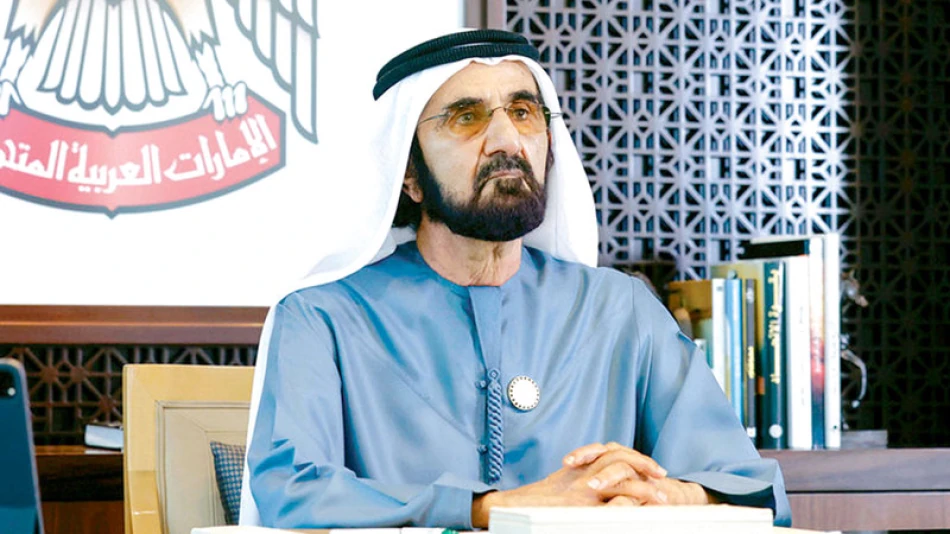
UAE's Transformative Leader: How Mohammed bin Zayed Drives Unprecedented Progress
UAE's Non-Oil Trade Surge Signals Gulf's Economic Transformation Beyond Petroleum
The United Arab Emirates has achieved a remarkable 24.5% growth in non-oil foreign trade during the first half of 2025, reaching AED 1.728 trillion ($470.3 billion) and dramatically outpacing global trade growth of just 1.75%. This explosive expansion, driven by comprehensive economic partnerships and strategic diversification, positions the UAE as a critical hub for international commerce while demonstrating how Gulf states are successfully reducing their dependence on oil revenues.
Record-Breaking Performance Across All Trade Categories
The UAE's trade figures reveal a comprehensive economic boom that extends far beyond typical cyclical growth. Non-oil exports alone surged by an unprecedented 44.7% to AED 369.5 billion, marking the highest growth rate in the nation's history. This performance is particularly striking when compared to the modest 1.75% global trade expansion, suggesting the UAE is capturing market share from established trading powers.
Sheikh Mohammed bin Rashid Al Maktoum, Vice President and Prime Minister of the UAE, emphasized the significance of these numbers in social media posts, noting that current trade volumes represent double the figures from just five years ago. This acceleration indicates not just recovery from pandemic-related disruptions, but a fundamental shift in the UAE's economic positioning.
Switzerland Partnership Delivers Exceptional Returns
The most dramatic bilateral trade growth occurred with Switzerland, where trade volumes jumped by an extraordinary 120%. This partnership likely reflects the UAE's growing role in commodity trading and financial services, sectors where Swiss expertise has traditionally dominated. The relationship suggests the UAE is successfully positioning itself as a bridge between European financial markets and Asian manufacturing centers.
Strategic Partnerships Drive Sustainable Growth
The UAE's Comprehensive Economic Partnership Agreement (CEPA) program has proven remarkably effective, with trade to partner countries under these agreements reaching AED 85.02 billion—a 62.8% increase. India leads this category with AED 51.45 billion in trade, representing a 97.6% growth that essentially doubled bilateral commerce.
This partnership-driven approach mirrors successful strategies employed by Singapore and Hong Kong, both of which leveraged strategic trade agreements to become regional commercial hubs. However, the UAE's scale and geographic positioning between Europe, Asia, and Africa provide unique advantages that neither Asian hub can match.
Diversification Beyond Traditional Partners
While China remains a crucial partner with 15.6% growth, the UAE's ability to achieve 29% growth with the United States and 41.4% with Turkey demonstrates sophisticated portfolio diversification. This balanced approach reduces dependence on any single market and provides resilience against regional economic disruptions.
Market Implications and Investment Opportunities
For international investors and trading companies, these figures signal several key opportunities. The UAE's re-export sector, growing at 14% to AED 389 billion, indicates robust demand for the country's logistics and warehousing infrastructure. Companies seeking regional distribution centers should consider the UAE's proven ability to facilitate trade flows across multiple continents.
The 22.5% growth in imports to AED 969.3 billion also suggests strong domestic consumption and industrial demand, making the UAE an attractive market for consumer goods and industrial equipment manufacturers.
Regional Competition and Global Context
The UAE's performance stands in sharp contrast to other regional economies struggling with slower growth. Saudi Arabia, despite its Vision 2030 diversification efforts, has not achieved comparable non-oil trade expansion. Qatar's focus on energy infrastructure and Kuwait's more limited diversification initiatives pale beside the UAE's comprehensive approach to economic transformation.
Globally, the UAE's 24.5% growth rate significantly exceeds performance in established trading economies. Even Singapore, long considered the gold standard for trade hub efficiency, has struggled to maintain such expansion rates in recent years.
Long-Term Economic Transformation
These trade figures represent more than cyclical growth—they indicate a fundamental restructuring of the UAE's economy. Non-oil exports now constitute 21.4% of total trade, up from 18.4% in 2024, demonstrating genuine diversification rather than simply increased oil revenues funding import growth.
The UAE's success in accessing markets representing three billion consumers through its partnership agreements creates a sustainable competitive advantage. Unlike commodity-dependent growth, this network effect becomes more valuable as additional partners join, creating powerful incentives for continued expansion.
For policymakers in other oil-dependent economies, the UAE model offers a proven pathway for economic diversification. However, replicating this success requires significant investment in infrastructure, regulatory reform, and diplomatic engagement—commitments that extend far beyond simple policy announcements.
 Sara Khaled
Sara Khaled







